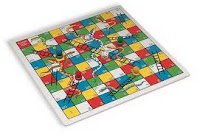My results were a bit like the game of 'snakes and ladders' (I think in the US it's called 'chutes and ladders') - up and down.
The overall picture for 2011 was pretty unexciting, with a slight fall in the value of investments (including reinvested income) of around -1%. However, income from the portfolio remained stable (at an average current yield of around 6%). This can be compared to the performance of the FTSE100, which was down 5.5%, with an average yield of around 4%.
I hope you did better!
I'll split the detailed results into sections (in line with the DIY Income Investor Income Pyramid approach) and give a little commentary on each:
- cash and savings
- dividend shares
- gilts (UK government bonds)
- corporate bonds
- ETFs
You will find details of the portfolio above on the 'Portfolio' tab.
Note that all our savings and investment income is tax-free.
Cash and Savings
The trend in available interest rates has been downward and, as I didn't expect this trend to change, I have opted to tie up any available cash up for longer periods, in return for higher returns. The interest rate on my current account remained broadly unchanged, although the bank dropped the highest tier rate.
The average rate on savings bonds was around 4.7% and other cash and savings around 2.8%.
Dividend Shares
This is the most volatile part of my portfolio and some ill-judged purchases (like Cable & Wireless Worldwide) knocked the generally good performance of the more regular dividend payers. In fact, I sold a couple of dividend shares whose capital values soared. All-in-all my yield on dividend shares is only 3.5%, less than that of the FTSE 100.
Gilts
My only (UK) government stock is the perpetual (undated) Consols 4%, which was yielding nearly 5% when I bought them - pretty good for something almost risk-free! Their yield has now fallen to just over 4%, meaning that the increase in their capital value is approaching my benchmark (of 5 years' income). I'm thinking about selling.
Corporate Bonds
I have been adding to my corporate bonds over the year (as well as the similar preference shares and PIBS). No big change there - just nice returns (current yield of over 7.5%).
ETFs
I did 'experiment' with two ETFs this year: one containing dividend shares and one based on non-financial corporate bonds. One went up and one went down, neatly cancelling each other out. I suppose that is good from the point of view of portfolio stability; not good from the point of overall returns, though!
Conclusions
So there you have the overall picture: portfolio value sliding down the 'serpents' (or 'chutes') of dividend shares but income racing up the 'ladders' of corporate bonds.
I'm still (carefully) buying interesting dividend shares (like Inmarsat) but I think the flavour of 2012 will be filling up on some of the nice yields available on corporate bonds - maybe even including the financials that everyone else is shunning? Apart from that, it looks like more of the same for 2012!
Anyway, good luck for the coming year - and do let me know about your successes in 2011 and any tips for 2012.
I am not a financial advisor and the information provided does not constitute financial advice. You should always do your own research on top of what you learn here to ensure that it's right for your specific circumstances.

Any reason why you should cut your winners that are still good divi paying shares? Surely you risk investing the gains into a share which may do poorly. Just playing devils advocate, its not a direct criticism of your technique.
ReplyDeleteCheers.
@3d-box
ReplyDeleteGood question, and selling is the hard part about investing.
Yes, the received wisdom is to hold winners and sell losers. But with dividend payers, the yield goes down as the price increases, so there comes a point where the yield is no longer attractive. Also high-yield shares normally don't appreciate much in value (the return is mainly through the dividend), so when they do, this usually represents a 'disturbance in the force'.
If the divi is still above average, I would continue to hold, or just sell half the holding.
"Yield goes down as price increases" Only if you keep buying more of the same stock. The yield you get is locked in when you buy and hopefully will increase with time.
ReplyDelete@Dan
ReplyDeleteYou are right, of course - I was not expressing myself clearly enough. Every investment has an 'opportunity cost' (i.e. the return that you could get in the next 'best' investment). As the price of the security increases, so does its opportunity cost, because its yield on the current price will change (usually falling, unless the divi has increased substantially). So I use the current yield and compare it with the increase in value of the share. Does that make sense?
Isn't that an overcomplication? How is your approach different to comparing current yield to YOC?
ReplyDeleteIf YOC rises over time, you've got it right one way (increased payout). If current yield drops, you've got it right the other way (capital appreciation). If both, happy days. On quality income equities at least (ie as long as you're not messing around with bungee-jumpers) a rising current yield helps put a soft floor under the SP. Or am I oversimplifying?
Jason
Jason,
DeleteThat's it - if the Yield on Cost remains high, it's a 'keeper' but if the current yield falls below my portfolio average then it is potentially a candidate for sale, assuming there is a capital gain. My simplistic 'sell' signal (capital gain in terms of years of current yield dividend) helps me identify securities I might want to sell (assuming that the current yield is low, and therefore could be improved by re-investment). The 5-year figure just seems to be - from experience - as high as the price tends to go, without falling back again.